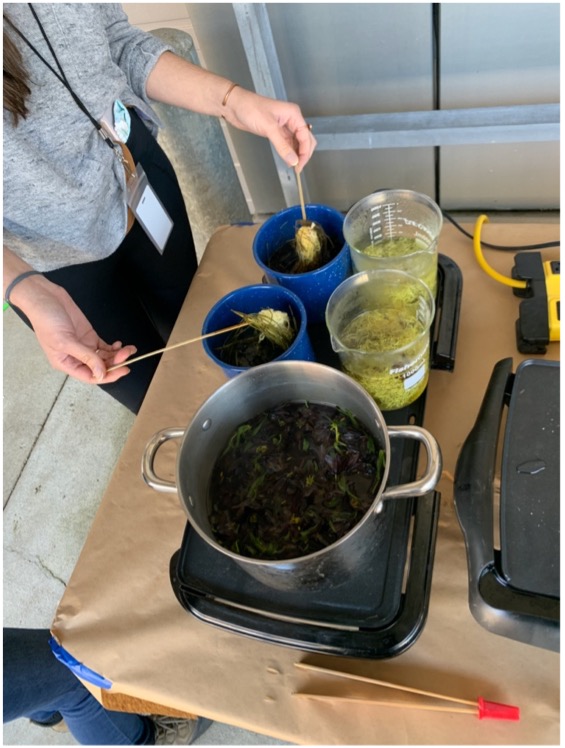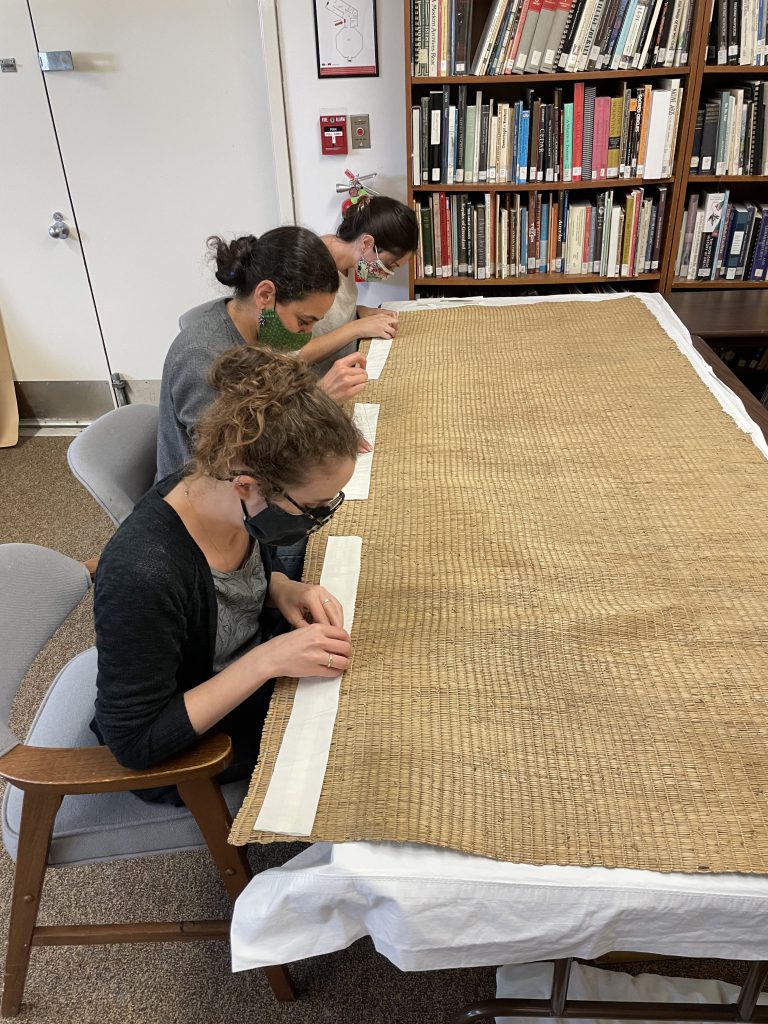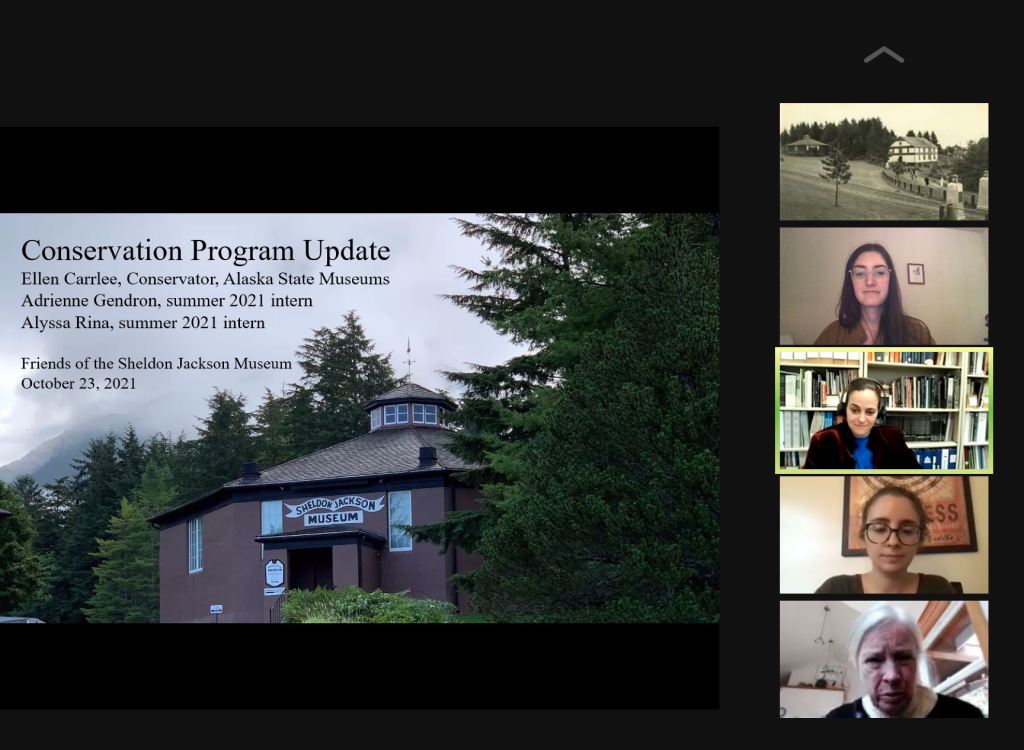Emerging art conservator Alyssa Rina’s summer was unlike any other. After attending Delaware Public Humanities Institute (DELPHI) in June, she flew to Alaska for her internship at the Alaska State Museum. There, Alyssa learned about ways of connecting with the communities.
Alyssa described the most memorable experience of her internship as participating in the Chilkat Dye Working Group, a community-centered initiative that is mutually beneficial to the Chilkat weavers while providing the opportunity for non-Native museum staff to learn about Indigenous perspectives.
The group was initiated by Liana Wallace (Auk’w Kwáan Tlingit) and Ellen Carrlee as a collaborative and experimental workshop to explore the technology of Chilkat weavings.
“Chilkat textiles feature curvilinear formline designs with yellow, black, and blue/green wool. The vivid colors were achieved by using local and traded materials, like plants, corroded metal, lichen, and more,” Alyssa added.
This workshop continues to nourish the intellectual and artistic curiosity of both parties by using oral information from weavers, ethnographic records, and technical literature to recreate Chilkat dye technology with non-toxic materials. Throughout her time assisting with the working group, Alyssa has interfaced with museum professionals and weavers, contributing to this respectful and engaging collaboration.

Alyssa holding up two samples from a dye bath of aged Horsetail (top) and freshly gathered Horsetail (bottom).
In June, Alyssa played an integral role in assisting with experimental yellow dye research during the Working Group meeting. She created dye baths with locally sourced Meadow Horsetail (Equisetum hyemale) and traded Wolf Lichen (Letharia vulpine). Samples of Horsetail and Wolf Lichen were weighed and submerged in tap water with yarn. The yarn and dyestuff simmered for 2 hours and soaked for 48 hours before being rinsed and dried. Yarns were compared from each dye bath to begin to answer several research questions: does Horsetail produce a different yellow dye compared to Wolf Lichen; does aged Horsetail and Wolf Lichen produce a different yellow hue compared to freshly harvested materials; is Wolf Lichen more shelf-stable? Information gathered from her experimental dye research was shared with weavers and her supervisor in a subsequent meeting in July. Finally, Alyssa compiled information gathered through ethnographic records, from literary sources, and by the weaving community about yellow dyes into a document that is easy to navigate. This resource will be shared with the weaving community for them to continue to build on or to use some of the information for dyeing wool.
However, one of her projects was affected by the rising Covid confirmed cases in Alaska.
“The Children’s Dye workshop was supposed to happen early August when I was still in Juneau.”
But the staff thought it would be best to reschedule it to minimize any kinds of health-related risks. After Alyssa came back home, object conservator Ellen Carrlee and Tlingit weaver Lily Hope ran the workshop using some of the notes she prepared, which included a hands-on yarn dying exercise using non-toxic dye sources, such as onion peels, turmeric, and red cabbage. The workshop showcased how wool, cotton, and synthetic fibers can result in different colored dyed yarns. Ultimately, the workshop provided access to cultural and educational resources for children by combining hands-on activity with critical thinking, encouraging them to develop their life-long learning skills, and integrating art with science for S.T.E.A.M.- based education.

Graduate interns Adrienne Gendron (front) and Alyssa Rina (back) sewing a cotton muslin sleeve onto the verso of a Yup’ik grass with Ellen Carrlee (center).
Another important task that Alyssa took part in was providing assistance to remounting Alaska Native woven textiles as part of the Sheldon Jackson Museum’s gallery refurbishment project. She co-authored articles about the conservation activities at both the Alaska State Museum and the Sheldon Jackson Museum in newsletters. Through this, Alyssa learned to think carefully about good ways to keep community members informed as to how their support assists preventive care and preservation of the collection.

(From top to bottom) Alyssa Rina, Ellen Carrlee, and Adrienne Gendron presenting to the Friends of the Sheldon Jackson Museum in late October via Zoom.
In October, Alyssa gave a virtual talk to recap the conservation activities at the Sheldon Jackson Museum to their Friends members. To make the content more accessible to the non-conservation audience, Alyssa and her colleagues used jargon-free language. The young conservator recounted her experience as a great way to further connect with the community and “remind them how much their support means to the collection and future conservation initiatives.”



